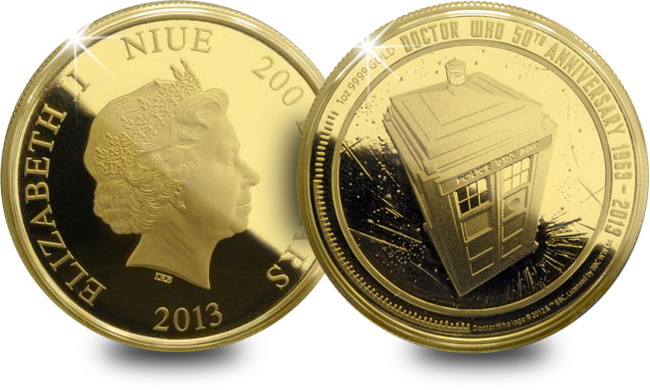Information
Doctor Who coin sells for 15 times its face value!
The New Zealand Mint were amazed when a Limited Edition Doctor Who Silver Coin, issued in collaboration with BBC Worldwide to celebrate the 50th Anniversary of the legendary TV show, created a bidding frenzy!
The Mint had put the coin on eBay as part of a charity auction and when the auction ended the winning bid was an incredible 15 times more than its face value! It just shows how popular Doctor Who memorabilia, particularly coins, is with collectors all over the world.
However, it’s not just on eBay where collectors have been fighting to add a Dr Who Commemorative coin to their collection. Within just four weeks of general release the Mint had sold more than half of the Doctor Who Silver Coin’s 10,000 edition limit. And now, just three weeks after the fantastic ‘Day of the Doctor’ 50th Anniversary episode was aired it is unlikely that the Mint have any left at all.
A Doctor Who 50th Anniversary Gold coin follows the success of the Silver coin, and with a mintage of just 250 worldwide this one will not be available for long either.
________________________________________________________________
The Doctor Who 50th Anniversary Silver coin.
Features the TARDIS in engraved relief on the reverse with coloured element. Comes in a special TARDIS presentation box complete with sound effects. Now sold out.
The Doctor Who 50th Anniversary 1oz Gold Coin
Features the TARDIS depicted in engraved relief on the reverse and presented in a deluxe wooden box. Now sold out.
The low-key Christening that’s of high interest to collectors.
Prince George Louis Alexander of Cambridge is set to make his second public appearance in his early life, amid a frenzy of public interest both here and around the world.
However, when the young Prince is baptised at the Chapel Royal in St James, there could be fewer than 60 people in attendance. All the public will see and hear of the 45-minute ceremony is the official photos and a few details which William and Kate choose to release the following day. So far the only photographs are family snapshots taken by Kate’s father Michael Middleton.
William and Kate’s wedding along with Prince George’s birth on 22nd July has been credited with bolstering the popularity of Britain’s Royal family both home and abroad.
Millions of people around the world watched live coverage of the Duke and Duchess leaving the hospital with their sleeping son – the only public sighting of George to date.
Australia and Canada among other Commonwealth countries have issued their own tributes to Prince George as the popularity of the Royal family continues to grow internationally.
In fact, Australia was the first major country to feature an image of young baby George on a commemorative coin – with a design portraying him with his proud mother and father.
Despite being held behind locked gates, royal fans are still expected to descend on St James’ Palace to soak up the atmosphere and wait patiently for a glimpse of the young Prince.
By removing the grandeur of the occasion, there is secrecy and intrigue surrounding the ceremony which has led to a surge in demand from collectors looking for a keepsake from what remains a hugely significant Royal event.

The DateStamp Royal Christening Sovereign is a collector’s favourite
In terms of commemorative coins, limited edition issues like the DateStamp™ Royal Christening Sovereign have been snapped up. Collectors not only look for the history and heritage of a Sovereign which you would expect for a future King, but also recognise the unique appeal of an Official Royal Mail postmark on the day of the Christening which captures the moment forever. With an edition limit of only 495, there has been a last-minute scramble to try and secure one.
Traditionally, it is seen as good fortune to cross a newborn’s palm with a silver coin, which also explains the incredible popularity of the Prince George Silver Proof £5 – struck from Sterling Silver and limited to just 2,013 pieces.
It’s certainly not a day that young George will remember, but for millions of others around the world, the christening of the future King of England is a day to be commemorated.
How well do you know your coins?
Half of Britons don’t know their own coins –
well that’s what the Royal Mint says…
A recent survey commissioned by the Royal Mint suggests that the British population has very little idea about the coins they use every day.
It seems that 17% of people had no idea that Queen Elizabeth II was featured on the obverse (head side) of British coins, with a slightly concerning 4% suggesting it was Queen Victoria and 3% former Prime Minister Margaret Thatcher.
As for the designs on the coins 68% struggled with what was on the penny and perhaps most remarkably practically half of the adult population (48%) were unable to identify the correct number of denominations currently in circulation.
Growing interest in circulating coin collecting
In fact the Royal Mint’s research flies in the face of growing interest in the UK’s circulating coinage. Fuelled by the incredible interest in the Olympic 50 pence coins, that has seen 70% of the 15,000,000 coins that went into circulation disappear – apparently into individual collections – change collecting has gathered considerable momentum over the last couple of years.
In fact there are currently 93 different £2, £1 and 50p coin designs and with only the very latest releases still to make banks and post offices, nearly all are available to collect in your change.
But with so little knowledge about our own coinage, it’s little wonder that some many collectors have turned to www.changechecker.org to track their collection and swap coins with other collectors. With over 75 swap requests being posted each day, we can be hopeful that Britons are rapidly re-educating themselves about their coinage.




